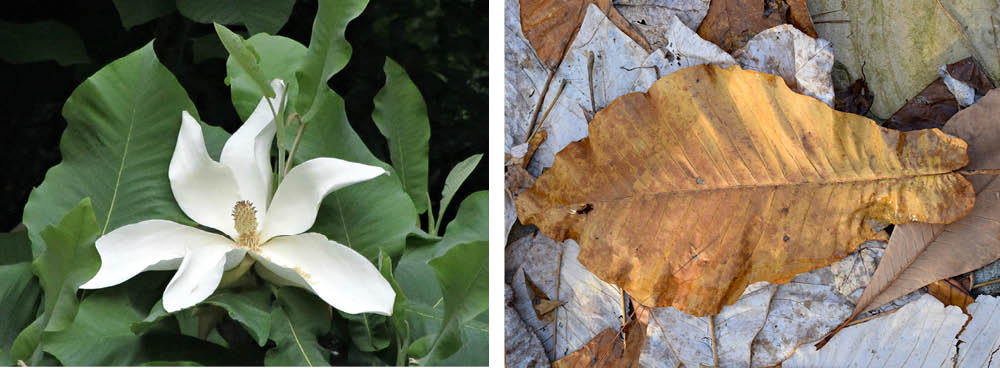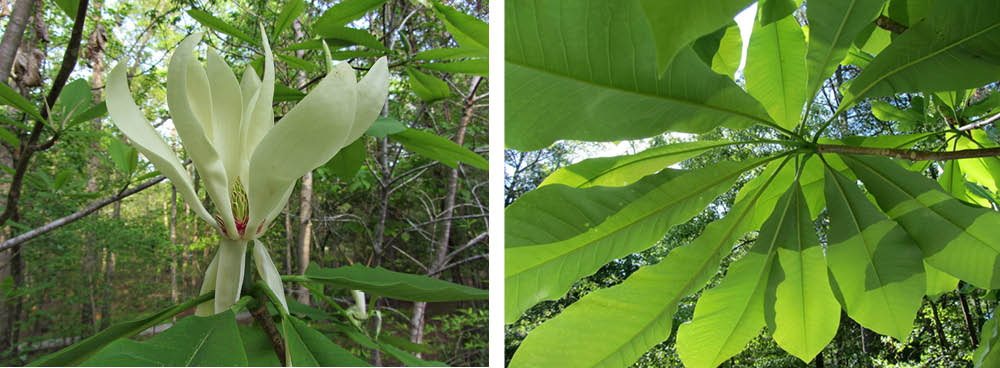The two native Georgia evergreen magnolias, left to right: southern magnolia (M. grandiflora) and sweetbay magnolia (M. virginiana).
May brings Magnolia flowers: waxy, white, fragrant blossoms that are an iconic symbol of Southern floral beauty. While the artistic depictions of magnolia flowers represent the Southern magnolia known botanically as Magnolia grandiflora, this species is not the only one in Georgia. We have two evergreen species and five deciduous ones to enjoy from one end of Georgia to the other – and most of these deserve more use in our landscapes. Did you know that magnolias are some of the first flowering plants to evolve? They are still pollinated by some of the earliest pollinators: beetles.
The two evergreen ones, Southern (Magnolia grandiflora) and sweetbay (Magnolia virginiana) are largely Coastal Plain residents. There is a variety of sweetbay that is naturally found in more northern areas (M. virginiana var. australis) and that is often the one propagated for sale. Both Southern magnolia, which has lots of cultivars now, and sweetbay are used extensively throughout Georgia now for their beauty, adaptability, and evergreen qualities. However, a word of caution: Southern magnolia has become a bit of a pest in Piedmont forests where birds have deposited its seeds. If you are driving around the Atlanta metro area and see Southern magnolia in the woodlands, it is not native there.
The five deciduous ones are considered ‘bigleaf’ type magnolias and include one mountain species, Fraser’s magnolia (M. fraseri), plus cucumber magnolia (M. acuminata), bigleaf magnolia (M. macrophylla), pyramid magnolia (M. pyramidata), and umbrella magnolia (M. tripetala). In addition, Ashe’s magnolia (M. ashei) is often sold in Georgia but is considered native to northern Florida.
The flower of a bigleaf magnolia (M. macrophylla) and its autumn leaf showing the distinguishing characteristic of an auriculate base.
All magnolias have the creamy white flowers, but one species is not fragrant. Umbrella magnolia flowers have a slightly funky odor. In my area, they bloom in late April and do not overlap the bloom time of their closest cousin, bigleaf magnolia. We find both of these species on GNPS rescues, most often in Cherokee County, and distinguish the two of them by the leaf base. Bigleaf magnolia has an auriculate base (shaped like an ear or a ‘B’), a trait that it shares with Fraser magnolia, pyramid magnolia, and Ashe’s magnolia. Umbrella magnolia has a cuneate base (wedge shaped or more like a ‘V’), a trait that it shares with cucumber magnolia.
The deciduous species are generally understory trees, enjoying morning sun but afternoon shade. Umbrella magnolias are naturally found in my Cherokee County neighborhood, so I’ve planted several of the bigleaf and umbrella magnolias adjacent to our swimming pool for a tropical effect. The 36-inch leaves of the bigleaf magnolia are stunning in the summer. These uncommonly used trees are a wonderful way to add interest and diversity to your landscape.
Flower and foliage of umbrella magnolia (M. tripetala).



